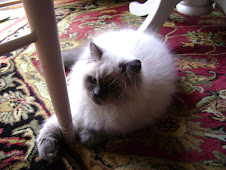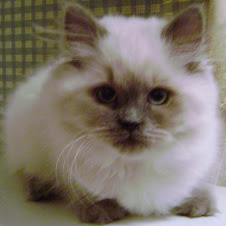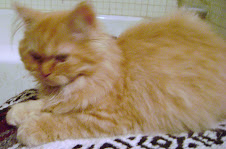
**********************************************************************************
A few years ago, a mother cat and her son, both jet black, had been abandoned by some one in the neighbourhood and had been reduced to skeletal proportions by their new lifestyle before I discovered them and began to leave food for them outside. For two months, they would eat only if I returned first to the house. It was only in the third month that I was able to stay nearby to watch them eat. A few months after that, I was able to persuade them to come into the house to eat and rest. By then, the mother was pregnant again.
When she was ready to have her kittens, I made a place for her in the house. The new litter was born inside the house and I found homes for all but one. That kitten become our pet, Lionheart. A home was found for the mother as well. Osiris, her eldest son, remained feral and although he would allow me to hold him and pet him, he would not stay inside the house. He would become increasingly distressed if, even in the worst weather, I tried to keep him inside.
Osiris was an uncommonly beautiful black cat with wide green eyes. I loved him dearly and wished that I could persuade him to stay in the house. He had a wild spirit, though, and although he loved to be held and even combed, he always insisted on making his escape after an hour or two.
He was hit by a car one morning at dawn. I grieved for him terribly and still miss him.
This morning, I found a cat outside napping in a nest of leaves. Some one in the neighbourhood owns this cat but allows him to roam outside. Although he does not have Osiris' extraordinary beauty, there is something about him that leads me to suspect that he may be Osiris' son or even grandson. It makes me happy to think of Osiris living on in his progeny, despite the fact that it is 'politically incorrect' to some extent.
This leads me to a danger to cats that can be as fatal as any car collision and can be caused by an act performed in the mistaken belief that it actually is protecting the animal against harm.
In 1991, a discovery was made to the effect that two common feline vaccines actually were responsible for the development of malignant tumours at the site of vaccination. These tumours, called 'fibrosarcomas' were linked to the vaccines for rabies and feline leukemia.
A task force formed to study the problem and make recommendations suggested that the leukemia vaccine should be administered SOLELY to cats who spent time outdoors. The rabies vaccine obviously should be administered only as absolutely required by law.
In any situation, both vaccines never should be given more than once every three years.
Finally, veterinarians were urged to change the site of injection from a site between the shoulder blades to one in the left rear leg near the ankle. The reason for this is that, should a malignant tumour develop at the site, any tumour between the shoulder blades is virtually impossible to remove. In the case of a tumour in the rear leg, amputation of the leg, however undesirable, could save the animal's life.
A paper published in February 2009 by the Journal of the American Veterinary Medical Association indicated that many veterinarians have ignored the recommendations of the task force. Not only have they continued to give these injections too frequently, they have not changed the site of the injection. Consequently, a significant number of cats have developed malignant tumours at an injection site between the shoulder blades.
As a cat lover, I believe it is vital to educate cat owners as to the dangers inherent in this practice. If the professional veterinarian refuses to educate himself/herself as to the risks these injection practices poses, the owner of the cat must be aware of the situation and insist either that the veterinarian not give the leukemia injection if the cat is an indoor pet or if the animal roams outdoors, give the injection only once every three years and use a rear leg for the site rather than placing it between the shoulder blades at an inoperable site.




No comments:
Post a Comment